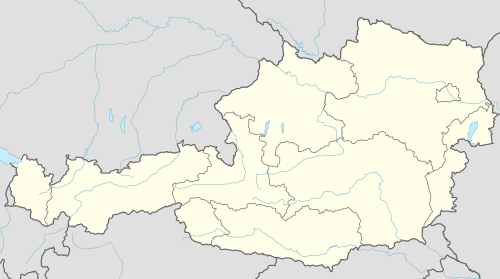Hinterbrühl
| Hinterbrühl | ||
|---|---|---|
| ||
 Hinterbrühl Location within Austria | ||
| Coordinates: 48°5′N 16°14′E / 48.083°N 16.233°ECoordinates: 48°5′N 16°14′E / 48.083°N 16.233°E | ||
| Country | Austria | |
| State | Lower Austria | |
| District | Mödling | |
| Government | ||
| • Mayor | Benno Moldan | |
| Area | ||
| • Total | 16.93 km2 (6.54 sq mi) | |
| Elevation | 280 m (920 ft) | |
| Population (1 January 2016)[1] | ||
| • Total | 4,024 | |
| • Density | 240/km2 (620/sq mi) | |
| Time zone | CET (UTC+1) | |
| • Summer (DST) | CEST (UTC+2) | |
| Postal codes | 2371, 2393 | |
| Area codes | 02236, 02237 | |
| Website | www.hinterbruehl.com | |
Hinterbrühl is a town in the district of Mödling in the Austrian state of Lower Austria. It is home to the Seegrotte, a system of caves including Europe's largest underground lake. During World War II, a satellite camp of Mauthausen concentration camp was opened inside the caverns, producing parts for the He 162 jet fighter.
History
Hinterbruhl was settled as early as 6,000 years ago. In 1182, the first named Hinterbrühler was found to be Gerungus de Prule.
Like the neighbor areas, Hinterbrühl suffered mightily under the two Turkish sieges of 1529 and 1683. Since a majority of the population was killed, the area was inhabited by settlers who moved north from Styria after 1683.
Since 1883, Mödling and Hinterbrühl Tram, the first electric streetcar in continental Europe, linked Hinterbrühl to Mödling railway station. It was closed on March 31, 1932. Today, only the Bahnplatz remains of this historic achievement.
On August 4, 1943 a satellite camp of Mauthausen concentration camp was built in the city. The prisoners there built parts, sub-assemblies and BMW 003 turbojet engines for the He 162 jet fighter in a hastily converted underground factory during late autumn and spring 1945. The 162, known as the Emergency Fighter or People's Fighter (Volksjäger) was an extremely lightweight, cheap and fast plane that could be discarded if it suffered any damage. Hinterbruhl was just part of a vast crash production program where dozens of factories of varying sizes would make parts for the jet, then send them to sites like Hinterbruhl for final assembly and transshipment to flight test centers — or even directly to airbases, such was the desperate last-minute nature of the enterprise.
In the last days of the war in 1945, the inmates of other camps had to make a 200 km-long march to the concentration camp Mauthausen in Hinterbrühl. Virtually none of them survived. Fifty-one inmates were killed even before the march by a gasoline injections or strangled by SS officers. In 1988 a monument was erected above the Subterranean Lake to honor the 51 victims of this massacre.
Population
| Historical population | ||
|---|---|---|
| Year | Pop. | ±% |
| 1869 | 1,231 | — |
| 1880 | 1,417 | +15.1% |
| 1890 | 1,708 | +20.5% |
| 1900 | 2,055 | +20.3% |
| 1910 | 2,408 | +17.2% |
| 1923 | 2,294 | −4.7% |
| 1934 | 2,462 | +7.3% |
| 1939 | 3,283 | +33.3% |
| 1951 | 3,228 | −1.7% |
| 1961 | 3,230 | +0.1% |
| 1971 | 3,677 | +13.8% |
| 1981 | 3,989 | +8.5% |
| 1991 | 4,150 | +4.0% |
| 2001 | 4,020 | −3.1% |
| 2011 | 4,068 | +1.2% |
Seegrotte
The Hinterbrühl Seegrotte (Lake Grotto) is a large underground lake located in Hinterbrühl. This grotto is an important historic site. It is open to the public for tours. The grotto is actually an old gypsum mine. By the end of 1800 it was used to make red and white plaster. In 1912 a blast released millions of gallons of water and flooded the lower caverns of the mine, creating the largest underground lake in Europe. In the 1930s a team of cave explorers found the lake and finally managed to open the grotto for the public. The upper (non-flooded) tunnels of the same old mine were reused by Nazi German authorities as an aircraft-manufacturing facility with the use of forced labor called Seegrotte.
Holdrichsmühle
Holdrichsmühle, an old mill, is an hotel in Hinterbrühl, that was featured on the 24g Austrian definitive stamp of 1945 (SG936). Holdrichsmühle was a regular subject for postcards from the late 1890s onwards. Many of these cards claim an association with the composer Franz Schubert, and there have been various plaques and internal features in support of these claims. Early postcards claim that Schubert wrote Die schöne Müllerin here, later cards claim that it was Der Lindenbaum (from Winterreise). There is no documentary evidence to support these claims, though there is a claim in Deutsch's Schubert: Memoirs by his friends [2] made by Hermann Rollett in 1897 that he had seen Franz Schubert at Holdrichsmühle around 1825 or 1826, when Rollett was aged seven.

References
- ↑ Statistik Austria - Bevölkerung zu Jahresbeginn 2002-2016 nach Gemeinden (Gebietsstand 2016-01-01), 2016-01-01.
- ↑ Otto Erich Deutsch (ed): Schubert: Memoirs by his friends, Macmillan, New York, 1958
External links
| Wikimedia Commons has media related to Hinterbrühl. |
